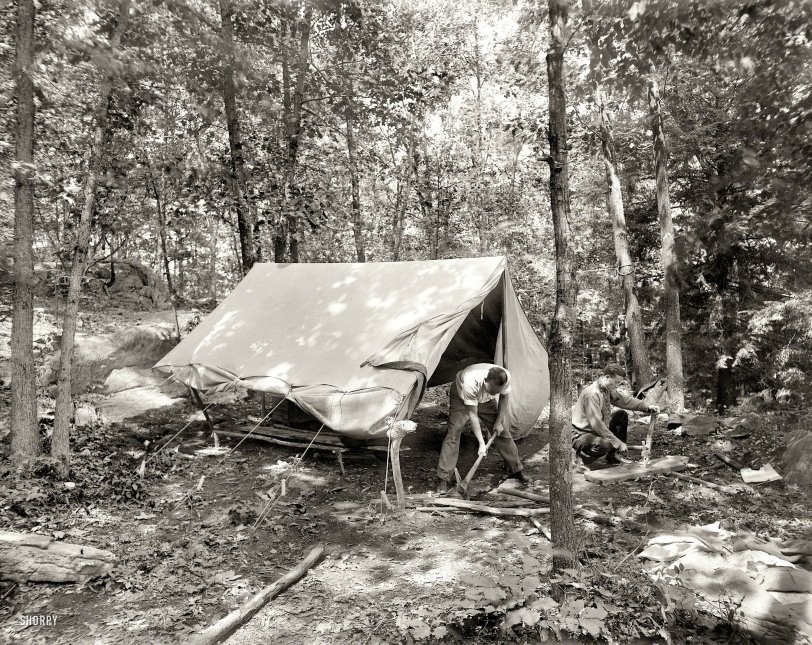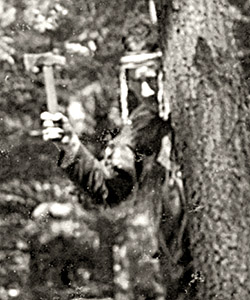


Framed or unframed, desk size to sofa size, printed by us in Arizona and Alabama since 2007. Explore now.
Shorpy is funded by you. Patreon contributors get an ad-free experience.
Learn more.

- Details, Details
- What's that building to the left of the tower?
- Coal Barges
- Bromo-Seltzer
- Inner harbor
- The Basin
- What a headache!
- Giant stepladder?
- Baldwin 62303
- Baldwin VO-1000
- Cold
- No expense spared
- Tough Guys
- Lost in Toyland
- And without gloves
- If I were a blindfolded time traveler
- Smoke Consumer Also Cooks
- Oh that stove!
- Possibly still there?
- What?!?
- $100 Reward
- Freeze Frame
- Texas Flyer wanted
- Just a Year Too Soon
- WWII -- Replacing men with women at the railroad crossing.
- Yes, Icing
- You kids drive me nuts!
- NOT An Easy Job
- I wonder
- Just add window boxes
Print Emporium
Danger Lurks: 1908

Cos Cob, Connecticut, circa 1908. "Owanoke Prospector's Camp -- Wyndygoul." Camping on the estate of writer-naturalist Ernest Thompson Seton, a founder of the Boy Scouts of America. Points of interest in this 8x10 glass plate: many trees camouflaging one ambush. Bain News Service. View full size.
High Camp Picturesqueness
I'm going to go out on a limb here and suggest we are looking at staged version of one of Seton's "games in Indian style."
St. Nicholas, an Illustrated Magazine for Young Folks,
Volume 39, January, 1912.
The Birch-Bark Roll Camp
A great many of our readers are familiar with the organization called “The Woodcraft Indians," or “Indian Scouts," originated by Ernst Thompson Seton, July 1, 1902, at Cos Cob, Connecticut. Mr. Seton established this camp with the main object, as he states in a letter to “Nature and Scientist," “To develop boys in the right direction mentally, morally, and physically by supplying wholesome, and especially outdoor, activities; aiming never to crush energy, but to direct it, believing that no boys are born bad. The bad ones are made by evil surroundings. Our mottos is ‘Manhood, not Scholarship, the object of Education.'" He tells us in “The BirchBark Roll," a hand-book of instructions for the woodcraft Indians (and this is practically another name for “Boy Scouts"), that "Sport is the great incentive to Outdoor Life; nature study is the intellectual side of sport." …
In the movement Mr. Seton puts recreation first and education second, and depends chiefly upon these principles: camp life, self-government, pursuits and games in Indian style, honors by standards, personal decoration, heroic ideals, and picturesqueness in everything. Of this he says: “Very great importance should be attached to this. The effect of the picturesque is magical, and all the more subtle and irresistible because it is not, the face of it, reasonable. The charm of titles and gay costumes, of the beautiful ceremony, phrase, dance and song, is all utilized to make the camp attractive and inviting to the boys."
Hatchet Job
The two guys digging and chopping are wearing dress shoes, dress pants, and the guy with the ax (who looks a tad like Kirk Douglas in profile) is even wearing a tie.
I realize that is pretty much the "dress code" of the era, but I could not see myself dressed like that on a camping trip. Shorts (and bug spray), T-shirt, sneakers would be best.
The only person dressed comfortably seems to be the attacker lurking behind the tree.
How times have changed!
I see the ambush
Whether it was staged or not I don't know, it was 1908 in Connecticut after all, and I thought we were pretty cool with the east coast Native Americans by this point.

Cos Cob has changed
If that tent were still around in Cos Cob today it probably would sell for $250K. The low-rent district, it's not.
























On Shorpy:
Today’s Top 5